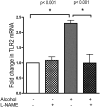Alcohol up-regulates TLR2 through a NO/cGMP dependent pathway
- PMID: 19860807
- PMCID: PMC3646526
- DOI: 10.1111/j.1530-0277.2009.01065.x
Alcohol up-regulates TLR2 through a NO/cGMP dependent pathway
Abstract
Background: Heavy alcohol consumption is associated with severe bronchitis. This is likely related to increased inflammation in the airways of alcohol abusers. Toll-like receptor 2 (TLR2) is an important mediator of inflammation in the airway epithelium. TLR2 initiates an inflammatory cascade in response to gram-positive bacteria. We have previously shown that alcohol up-regulates TLR2 in the airway epithelium. However, the mechanism of alcohol-mediated up-regulation of TLR2 has not been identified.
Methods: A human airway epithelial cell line, 16HBE14o-, was exposed to biologically relevant concentrations of alcohol (100 mM) in the presence and absence of N(omega)-Nitro-l-arginine methyl ester hydrochloride, a nitric oxide (NO) synthase inhibitor; and Rp-8-Br-cGMP-S, an antagonist analogue of cGMP. TLR2 was measured using real-time PCR and Western blots. In addition, 16HBE14o- cells were incubated with sodium nitroprusside (SNP), an NO donor, and 8-Br-cGMP, a cGMP analogue. TLR2 was measured using real-time PCR.
Results: N(omega)-Nitro-l-arginine methyl ester hydrochloride blocked the alcohol-mediated up-regulation of TLR2. This indicates that NO plays a key role in alcohol's up-regulation of TLR2. SNP, a NO donor, up-regulated TLR2. Rp-8-Br-CGMP-S attenuated alcohol's up-regulation of TLR2, suggesting that NO was working through cGMP/PKG. 8-Br-cGMP up-regulated TLR2, also demonstrating the importance of cGMP/PKG.
Conclusions: Alcohol up-regulates TLR2 through a NO/cGMP/PKG dependent pathway in the airway epithelium. This is an important observation in the understanding how alcohol modulates airway inflammation. In addition, this is the first time that cyclic nucleotides have been shown to play a role in the regulation of TLR2.
Figures





References
-
- Akira S, Takeda K. Toll-like receptor signalling. Nat Rev Immunol. 2004;4(7):499–511. - PubMed
-
- Baik JE, Ryu YH, Han JY, Im J, Kum KY, Yun CH, Lee K, Han SH. Lipoteichoic acid partially contributes to the inflammatory responses to Enterococcus faecalis. J Endod. 2008;34(8):975–82. - PubMed
-
- Bradford MM. A rapid and sensitive method for the quantitation of microgram quantities of protein utilizing the principle of protein-dye binding. Anal Biochem. 1976;72:248–54. - PubMed
-
- Browner NC, Dey NB, Bloch KD, Lincoln TM. Regulation of cGMP-dependent protein kinase expression by soluble guanylyl cyclase in vascular smooth muscle cells. J Biol Chem. 2004;279(45):46631–6. - PubMed
Publication types
MeSH terms
Substances
Grants and funding
LinkOut - more resources
Full Text Sources

